Leichner (1910-1945)
Continued from: Leichner
Continued onto: Leichner (post 1945)
Most writers suggest that after the death of Ludwig Leichner [1836-1912], the firm passed into the hands of his youngest son, Siegfried Leichner [1889-1962]. However, Leichner’s eldest son, Gustav Adolf Leichner [b.1860], also appears on a number of documents associated with the firm through to the late 1920s.
It seems likely that Leichner left his estate to his wife and/or the whole family. Gustav and Siegfried appear to have had an amicable relationship as together they establish a Leichner branch at Wiedenergüertel, 58, Vienna in 1913. Leopoldine died in 1914 and Gustav was dead by 1929 and this seems to be the point when Siegried took sole control of the firm. I have no firm records of the activities of Leichner’s other son, Jacob [b.1866], or his interests in the company. If he went under the name of Fritz Leichner then he travelled the globe as the company’s sales representative.
After 1912, Leichner appears to have been a greater emphasis on promoting its perfumes and general make-up, best shown in the more sophisticated advertising of the period.
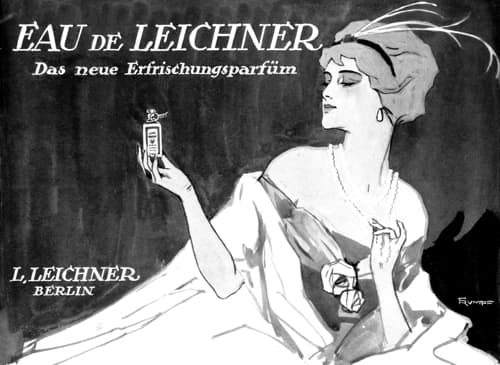
Above: 1913 Eau de Leichner.
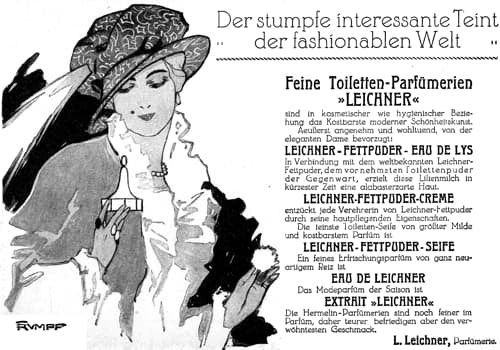
Above: 1914 Leichner fine toiletries and perfumes.
Unfortunately, the outbreak of the First World War in 1914 halted further changes in the company’s development.
War
Gustav Leichner appears to have been wounded during the hostilities but Siegfried was unscathed, receiving the Iron Cross Second Class for his role in the development of an automobile deployed on the bad roads of the eastern front.

Above: 1915 Siegfried Leichner in the war car. It had a 100hp engine and a range of 120 kilometres.
Sales of Leichner products both at home and abroad were depressed during the hostilities. Strong anti-German sentiment generated during the war also meant that sales outside Germany did not quickly rebound even after embargoes on German goods were lifted, a situation that lasted well into the 1920s. An example of this hostility can be seen in ‘The Stage’. This leading London theatrical trade newspaper was still refusing to accept Leichner advertisements in 1922.
An attempt is being made by Leichners to recapture the grease paint trade in this country. We have done without German grease paints for so long, and found the better-class English brands so satisfactory, that surely there is no occasion to go back to the foreign article now. So far as this paper is concerned, advertisements which have been offered for Leichners’s grease paints have been refused.
(The Stage, Thursday 13 April 1922, p. 14)
Anti-German feeling may have been part of the reason why Leichner began decentralising its product production in the 1920s. By 1928, it had manufacturing facilities at Ferrograsse 35, Vienna; 16 Rue d’Orléans, Paris; 11-12 Pollen Street, London; 130 West 17th Street, New York; and 3838 Calle Victoria, Buenos Aires. The fortunes of these branches were mixed. The French company was liquidated in 1933, the American branch also disappeared in the 1930s, and the Argentinian company folded in 1947. Things were better in Britain with the company there growing to become the largest and most important part of Leichner.
Leichner (England)
L. Leichner (England) Ltd., was established (capital of £2,000) in 1922. Its registered office was at 15a Whitcomb Street, London, the address of its British distributor, Vanities Limited. In 1925, the company opened a London office at 27 Harcourt Street, Marylebone managed by Stephen Pollitzer [c.1880-1962]. Born on the Continent, Pollitzer was a sales representative in Canada before joining Leichner. He would stay with the firm for the next thirty years.
In 1928, L. Leichner (London) Ltd. was founded at 11-12 Pollen Street (capital £10,000) to manufacture, import and export Leichner cosmetics and stage make-up. The company directors were Siegfried Leichner and Stephen Pollitzer.
In 1931, the company began manufacturing at Leichner House, 30-32 Acre Lane, Brixton. Producing products in Britain had a number of advantages. Leichner could now claim that its products were ‘British made’, which helped diminish any anti-German sentiment. It also enabled the company to avoid some of the new import duties the British government imposed to protect its industries during the Great Depression. Local production also made it easier for Leichner to respond to requests from the British film industry to help them solve make-up problems.
Professional make-up
The growth of the motion picture industry opened up additional uses for Leichner greasepaints. Foan & Wolters suggest that Leichner was the first company to produce make-up specifically for film (Foan & Wolters, 1950, p. 446).
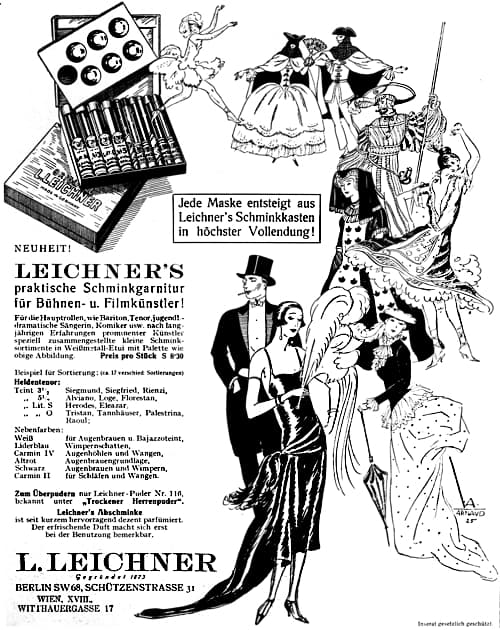
Above: 1925 Leichner practical make-up sets for stage and film arts.
Leichner greasepaint was employed in numerous early silent films, particularly in Germany where film makers had direct access to Leichner expertise early on. Fritz Lang [1890-1976], for example, used Leichner make-up when filming his epic two part film, Die Nibelungen, released in 1924.
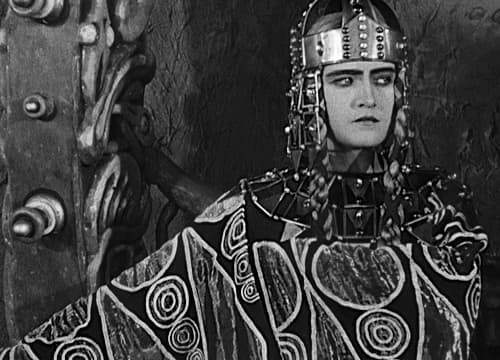
Above: 1924 Die Nibelungen: Kriemhilds Rache (Kriemhild’s Revenge) (Pommer & Lang, 1924).
Leichner also supplied make-up for colour photography and later added ranges for the developing medium of television.
Stage
By the 1920s, Leichner was selling a complete range of theatrical make-up including stick, cream and liquid greasepaints, loose and compact powders, liquid powders, face creams, lip and eyebrow pencils along with a wide range of theatrical sundries.

Above: 1926 Leichner theatrical make-up.
The full list is far too extensive to number but can be viewed in the Artists Catalogue Leichner first published in 1926.
See also: Leichner Artists Catalogue (c.1926)
Looking specifically at greasepaints, it is worth noting that Leichner was selling cream greasepaints in tubes (Tuben-Schminke) by 1925. The company had been making cream greasepaints well before this but this new packaging matched Max Factor’s Supreme Greasepaint released in 1923.
See also: Max Factor
In 1925, to help inform actors and actresses on how best to use Leichner make-up, Siegfried Leichner opened a make-up school in Berlin with Ernst Loss as its director.
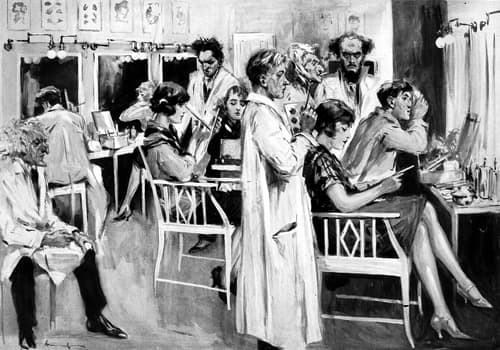
Above: 1925 Drawing of the interior of the Leichner Make-up School with students demonstrating a range of make-ups.
Film
The idiosyncrasies of blue-sensitive film stocks and mercury-vapour and carbon-arc lights used in early silent films meant that performers could not use their stage make-up routines in motion pictures. Leichner recommended using bright yellow, green and violet greasepaints when filming, such as Leichner No. 5 Chinese, No. 13 Red Brown, No. 336 Green III, No. 338 Green and No. 337 Lilac. The company also manufactured light and dark versions of Film Clear, a product said to reduce the appearance of wrinkles on film, an important consideration during close-ups.
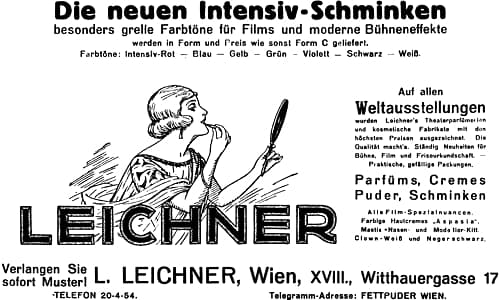
Above: 1924 New intensive Leichner make-up in especially bright colours for film and modern stage effects in Form C sticks (Austria).
See also: Early Movie Make-up
The arrival of panchromatic film stocks combined with new forms of lighting – widely employed by the 1930s – allowed for more natural forms of make-up. Information on the German production of Leichner panchromatic make-up is sparse but it would appear that company introduced Leichner Panchromo in 1928, the same year that Max Factor developed his Panchromatic Make-up.
See also: Panchromatic Make-up
Leichner Panchromo was only available in four shades – Women (Light and Dark), and Men (Light and Dark) – but it was available in sticks, powders and creams (tubes and jars). By 1936, Leichner had added Allcromo, a cream make-up. I do not have a complete list of its available shades but numbers ranged from at least A.108 to A.120.
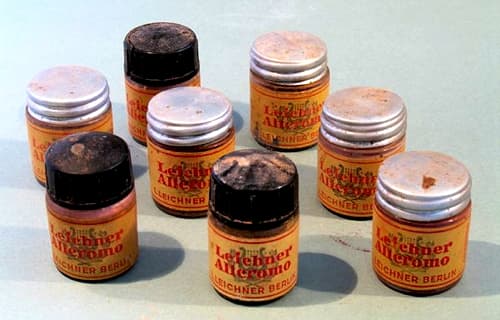
Above: Leichner Allcromo make-up
In Britain, Allcromo was known as Kamera Klear Cinema Make-up with the term Panchromo being restricted to panchromatic greasepaint sticks which came in I, II, III, IV, V, VI and G shades. By 1938, Kamera Klear was being sold in Britain in the following shades: KK.4 (Ladies’ Blonde), KK.5 (Ladies’ Fair), KK.6 (Ladies’ Brunette), KK.7 (Ladies’ Dark) KK.8 (Gent’s Light), KK.9 (Gent’s Brunette), KK.10 (Gent’s Dark), Sunburn and Indian). It was also available as a liquid make-up sold in small glass bottles (Shades: KK.4, KK.5, KK.6, KK.7, KK.8, KK.9, and Sunburn).

Above: 1938 Leichner Cinema Make-up (Kamera Klear and Panchro).
Kamera Klear Cinema Make-up was complemented with Kamera Klear Powder (Shades: KK.4, KK.5, KK.6, KK.7, KK.8, KK.9, Rose, Brownish, and Rose Gold). For the eyes there was Leichner Eyeshadow (Shades: Cinema Brown (light and Dark), Gray (Light and Dark), Gold Green, Gold Brown, Gold and Silver) and Leichner Cinema Cosmetic (mascara) (Shades: Black and Brown). For lips Leichner supplied Leichner Cinema Lip Rouge (Shades: Cinema Light, Cinema Dark, Cherry, Scarlet, Carmine, Vermillion and Brilliant).
Also see the booklet: Handbook on Make-Up for Stage and Screen (1938)
In 1937, Leichner (London) also followed the example set in Berlin and opened a make-up service. Situated in Regent Street it supplied advice to clients on how best to select and use the various forms of Leichner make-up.
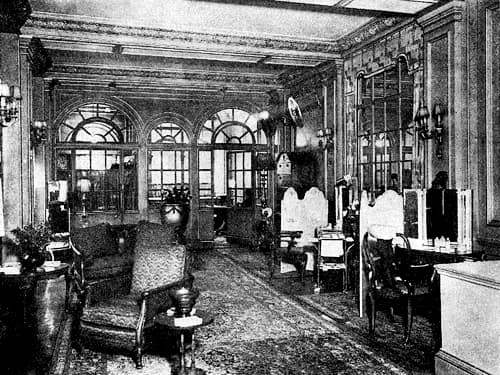
Above: 1938 Leichner Make-up and Beauty Service in Regent Street,.
Television
Germany was an early adopter of television and used it to broadcast the 1936 Summer Olympic games in Berlin.
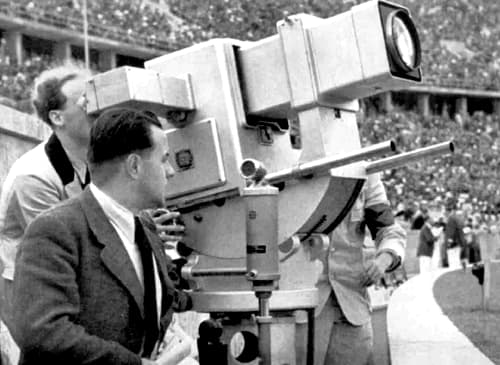
Above: 1936 Television camera at the Berlin Olympics broadcast to viewing rooms around Berlin.
Leichner developed a limited range of make-up for early black and white television in the 1930s consisting of Spotlite Klear Television I, and II, Television Special for Lips, and Kamera Klear Television Powder.
General cosmetics
Leichner added some ancillary beauty lines in the 1920s and 1930s, the most notable being Leichner No. 1001 Das Schlankheitsbad, known in Britain as The Slim Figure Bath. Released in Germany in 1927, it was a bath salt used to help reduce body weight. By 1932, Leichner had added an ankle slimmer, Leichner No. 1002.
Slim Figure Bath Leichner 1001: “Besides restoring your figure to its natural slim lines, Leichner 1001 is an ideal Beauty Bath, since it makes the skin soft and white and removes impurities.”
Another ancillary beauty product introduced in this period was Leichner Beauty Hormones. Available in Germany they were released in Britain in 1931, in boxes of 25 or 50 tablets.

Above: 1933 Leichner Jugend-Hormone.
Leichner Beauty Hormones: “[H]ave the special function of stimulating the formation of new and perfect cellular tissue, which means nothing less than complete rejuvenation of the skin and the outlines of the human body.”
Leichner also expanded its range of general cosmetics during this period. To increase their appeal, the company also modernised its packaging.
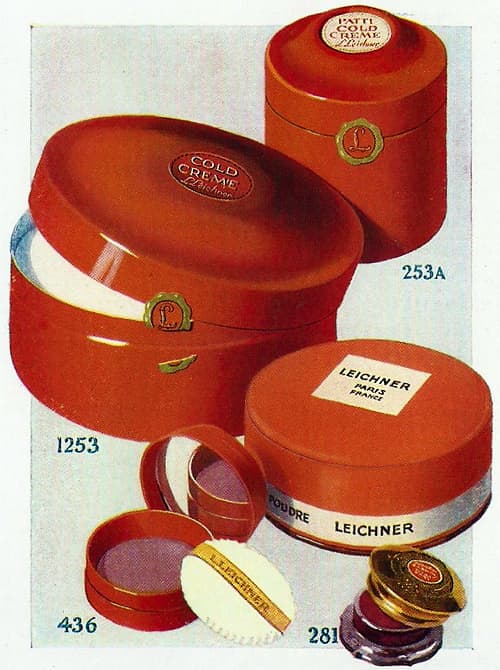
Above: New Leichner packaging introduced from 1927.
Leichner also improved its advertising to give its products greater consumer appeal.
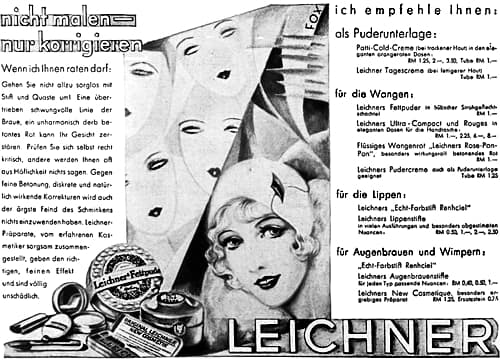
Above: 1930 L. Leichner: nicht malen – nur korrigieren (don’t paint – just correct).
Skin-care
Unfortunately, information from Germany is sparse so I will concentrate on developments in Britain. Leichner’s British product list from the beginning of the 1930s only included a limited skin-care range – Leichner Removing Cream, Patti Cold Cream, Leichner Vanishing Cream and Leichner Nose Cream – with most of these products involved in the removal or application of Leichner make-up.
Also see the Leichner booklet: Every Woman Beautiful (c.1931)
During the 1930s, Leichner (London) made a concerted effort to develop a basic skin-care-system. By 1935, it had added Leichner Astringent Lotion, Day Cream for Greasy Skins, Vitamin Skin Food, and Vitamin Complexion Milk and organised them into a basic skin-care system.
Astringent Lotion: “[A]bsorbs superfluous oiliness and through its antiseptic properties has a rejuvenating action on the pores. There is no drastic action, but a mild and persistent restoration of the pores to their normal condition.”
Day Cream for Greasy Skins: “[P]revents excessive oiliness, produces a smooth velvety skin surface, and is the best foundation for Rouge and Powder for greasy skins.”
Vitamin Skin Food: “[A] nourishing cream which penetrates and is completely absorbed by the tissues; it revitalises the lower cells and keeps the skin firm, fresh and resilient.”
Vitamin Complexion Milk: “[S]erves the same function as Vitamin skin Food but is less greasy.; and has a mild but progressively corrective action on the excessively greasy exudation.”
In 1936, two products were added to the range: Leichner Hormone Cream to be used at night, and Leichner Facial Pack, a face mask used to help remove blackheads and other impurities. Used once a week, the Facial Pack was laid on the skin for twenty minutes before being washed off with warm water. Leichner then recommended applying Leichner Astringent Lotion to close the pores.
Hormone Cream: “The regular application of this cream will produce a decided improvement in the appearance of the skin, relaxing tissues will tighten up, lines and wrinkles will be suppressed, and the freshness of the complexion revived.”
Facial Pack: “[D]raws such impurities as blackheads, etc. out of the skin without causing damage to the fine facial tissues and leaves you with a spotlessly clean and radiant complexion.”
Make-up
As might be expected from a company that produced make-up for stage and screen, Leichner had a well-developed general make-up range largely appropriated from its professional offerings.
In 1930, the Leichner (London) range still included Fettpuder, now renamed as Poudre Leichner, with Leichner adding a lighter version, Poudre ‘Invisible’.
Poudre Leichner: “A fragrant face powder that clings . . . an opalescent bloom that lends a new radiance to the complexion—cleverly shaded to add interest to the natural colouring. Constant use … visibly refines the texture of the skin—leaving it free from blemish.“ Shades: Naturelle, Rachel, Brownish, Apricot and Ocre.
Poudre Leichner Invisible: “[A] powder of superfine texture made for fine skins. … It imparts the smooth matt finish and exquisite beauty of a perfect complexion.” Shades: Blonde, Rachel, Apricot-Peach and Brownish.
Leichner powders were applied with a large puff over a skin cream or foundation, either Patti Cold Cream, Leichner Vanishing Cream, Creme Coloree, or Creme Email.
Leichner Creme Coloree was a tinted version of the Leichner Vanishing Cream and was a replacement, or rename, of the older Aspasia Cream. Like the Aspasia Cream it only came in tubes. Creme Email was a denser formulation originally suggested for evening wear. Produced in a range of shades it was later recommended as an all-purpose foundation that provided good coverage.
Creme Email: “[A] soft, protective, non-greasy cream which gives and absolutely smooth and flawless skin surface and is delightful to touch. It conceals blemishes and imperfections, is beneficial to the skin, does not clog pores, and is an entirely new foundation for rouge and powder.” Shades: Blonde, Rachel, Apricot-Peach and Brownish.
Other make-up items included cream and powdered rouges, liquid and block mascaras, eyeshadows, eyeliners, lipsticks and lip pencils. Leichner also developed a Nail Varnish in four shades.
Colour coordination
The shade ranges sizes for the different forms of Leichner make-up varied wildly. For example, Leichner rouges could be found in up to twenty shades by 1935 (including No. 12, Rose Marie, Mandarine, Mandarine Rose, Rose Bebe, Corail, Carmine Light, Carmine Dark, Carmine Extra Dark, Brunette 1, Brunette II, Brunette III, St. Moritz, Framboise, Orange, Riviera, Rose Petunia, and Strawberry), but Leichner lipsticks only came in five shades (Cherry, Orange, Light, Dark, and Extra Dark).
Colours were meant to be coordinated selected according to whether a woman was one of two broad skin colour types – Fair or Dark – combined with her hair colour.
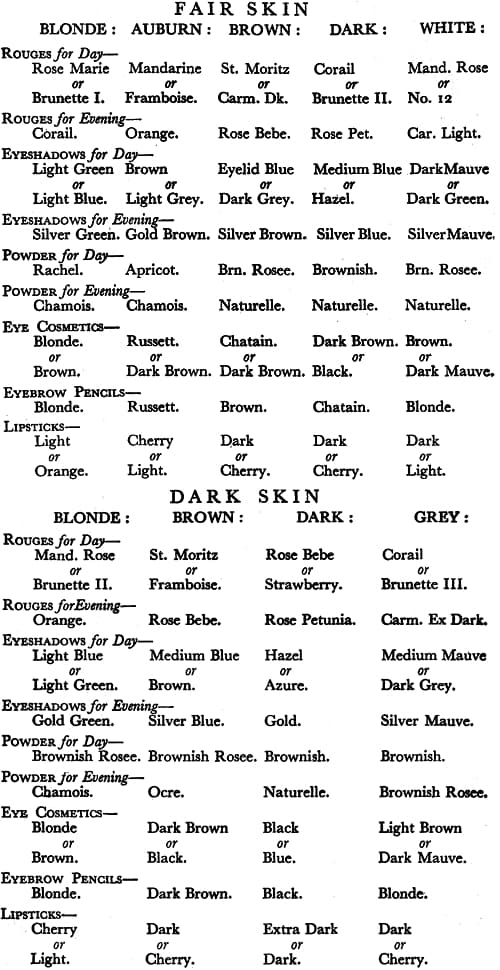
Above: c.1934 Leichner colour coordination chart for Light and Dark skin types and a range of hair shades.
Also see the booklet: Every Woman Beautiful (c.1934)
Towards the end of the decade, Leichner (London) added a Liquid Cream Foundation in four shades. Its appearance, formulation and shade range suggests that it may have been a general consumer version of Kamera Klear.
Liquid Cream Foundation: “[C]ool—soothing, and makes the skin feel like silk. Being neither dry or greasy, it can be used with equal success on every type of skin. A little should be massaged into the skin until absorbed, then make-up and powder applied in the usual way.” Shades: Blonde-Fair, Blonde-Dark, Brunette-Fair, Brunette-Dark.
Leichner Cosmetic System
In the interwar period, Leichner made a concerted effort to integrate its skin-care and make-up ranges. In Britain this was promoted as the Leichner Cosmetic System. It began with a thorough skin cleansing using creams and lotions rather than soap and water followed by an astringent with the emphasis on clearing, then closing, the skin pores.
Use Leichner Removing Cream (Cleansing Cream). This is an emollient, liquefying cream, made without water, and is not absorbed by the skin tissues. It has special detergent properties and takes every foreign particle off the skin and out of the pores. Leichner Removing Cream should be applied all over the skin surface and wiped off with Leichner Cleansing Tissues or a soft towel. The whole skin surface and the pores will then be absolutely clean, but a thin greasy film remains, which should be removed by applying:
Leichner Cleansing Lotion. This lotion is a most important innovation and its value for the preservation of the natural freshness of the skin cannot be overestimated. It is very cooling and refreshing, and restores the skin to its normal condition by its mild and persistent astringent action; distending pores close up and any tendency to relaxation is corrected in a natural way.(‘The Leichner cosmetic system,’ c.1932, p. 2)
The Leichner Removing Cream may have been a type of liquifying cream which would leave an oily residue that needed removing with the Cleansing Lotion. After 1935, Leichner Cleansing Lotion was replaced with, or renamed as, Leichner Astringent Lotion.
Also see: Liquifying Cleansing Creams
Cleansing was followed with a skin food, either Patti Cold Cream, Vitamin Skin Food or Vitamin Complexion Milk.
Leichner Patti Cold Cream is most suitable in the majority of cases. It is a sterilised skin food—a true skin tonic—as it penetrates into the lower skin layers and the supporting tissues, particularly when applied with gentle massage. The effect of this penetration is to maintain or reinstate the natural conditions. The tissues are toned up from within outwards; if they are under-nourished or drawn the contour is restored; any tendency to relaxation or enlargement of pores is corrected. The surface effect is very marked. If the skin happens to be dry, Leichner Patti Cold Cream supplements the deficiency of secretion; the whole of the skin rapidly becomes resilient and velvety to the touch and the formation of lines and wrinkles is avoided. Leichner Patti Cold Cream should be applied at night, and in the morning before applying any make-up.
When the skin tends to become inert and dull, or to sag, Leichner Vitamin Skin Food will be found preferable as it is a more active skin food and has a definitely astringent effect, needful in such cases. It revitalises and strengthens both the skin and the underlying tissues, and contains ingredients which stimulate cellular reconstruction. This skin food should be applied at night and well rubbed into the skin.
If the skin is distinctly greasy, the use of Leichner Vitamin Complexion Milk is specially recommended. It serves exactly the same purpose as the Vitamin Skin Food, but is less greasy, and has a mild but progressively corrective action on the excessive greasy exudation.(‘The Leichner cosmetic system,’ c.1932, pp. 2-3)
By the 1930s, few companies were suggesting using a cold cream as a skin food without including a ‘nutrient’ such as lanolin. Vitamins, on the other hand, were considered to be beneficial and many cosmetic companies added them to skin creams in the 1930s.
Also see: Skin Foods and Vitamin Creams
During the day a skin food could be replaced with one or other of the Leichner foundations or surface creams – Leichner Vanishing Cream, Creme Coloree, or Creme Email with Leichner Nose Cream used to reduced redness.
Leichner Vanishing Cream for softening the outer skin layer serves as a foundation cream for powder and is most refreshingly perfumed.
Leichner Creme Coloree is delicately tinted vanishing cream, supplied in the same shades as Poudres Leichner and will again be found very suitable as a basis for powder. Applied to the hands, it effectively suppresses any appearance of redness and makes the hands look soft, smooth and well cared for.
Leichner Creme Email (Enamel Cream) is a special foundation cream, prepared for evening make-up. In addition to its tonic properties, it ensures the appearance of an absolutely perfect skin surface, which remains unaltered after the application of Leichner Evening Powder.
Leichner Nose Cream is applied as a corrective of a noticeably red nose. It is an excellent powder basis and definitely suppresses the much disliked shiny nose appearance.(‘The Leichner cosmetic system,’ c.1932, p. 3)
As mentioned earlier, Leichner introduced another foundation, Leichner Liquid Cream Foundation, later in the decade. Women would select a foundation depending on how much covering power was needed and whether added colour was preferred. After the foundation, powder, rouge, lipstick and eye make-up would be applied.
Also see the booklet: The Leichner Cosmetic System (c.1932)
War
In 1936, Leichner celebrated the 100th anniversary of the birth of the company founder.

Above: 1936 Leichner celebrations of the birth of its founder, Johann Ludwig Leichner [1836-1912] at Schützenstrasse 31 in Berlin.
Unfortunately, war followed a few years later. It would have a devastating effect on the German operations with the building at Schützenstrasse 31, Berlin destroyed by allied bombing in 1945. Leichner (London) faired better. Promoting itself as British, it avoided closure and remained in operation right through the war.
Timeline
| 1913 | Branch established at Wiedenergüertel, 58, Vienna. |
| 1922 | L. Leichner (England) Ltd. founded. |
| 1925 | London office opened at 27 Harcourt Street, Marylebone. Make-up School established in Berlin. |
| 1927 | New Products: No.1001 Das Schlankheitsbad. |
| 1928 | L. Leichner (London) Ltd. founded at 11-12 Pollen Street. New Products: Leichner Panchromo. |
| 1929 | L. Leichner (Vienna) becomes an independant organisation. |
| 1931 | Leichner House opens at 30-32 Acre Lane, Brixton. New Products (UK): Leichner Hormones. |
| 1933 | Leichner (France) liquidated. |
| 1935 | New Products (UK): Poudre Leichner Invisible. |
| 1936 | New Products (UK): Hormone Cream, and Facial Pack. |
| 1937 | Make-up Service opened in Regent Street, London. |
| 1938 | New Products: Flüssiger “seiden”-strumpf. |
| 1945 | Berlin factory destroyed. |
First posted: 30th September 2020
Sources
Artists catalogue [Booklet]. (c.1926). London: L. Leichner.
Foan, G. A., & Wolters, N. E. B. (Eds.). (1950). The art and craft of hairdressing: A standard and complete guide to the technique of modern hairdressing, manicure, massage and beauty culture (New ed.). London: New Era Publishing Co. Ltd.
Every woman beautiful [Booklet]. (c.1931). London: L. Leichner.
Every woman beautiful [Booklet]. (c.1934). London: L. Leichner.
Handbook on make-Up for stage and screen [Booklet]. (1938). London: L. Leichner.
Hartnoll, P. (Ed.). (1967). The Oxford companion to the theatre (3rd ed.) London: Oxford University Press.
The Leichner cosmetic cystem [Booklet]. (c.1932). London: L. Leichner.
Leichner guide for perfect make-up [Booklet]. (c.1935). London: L. Leichner.
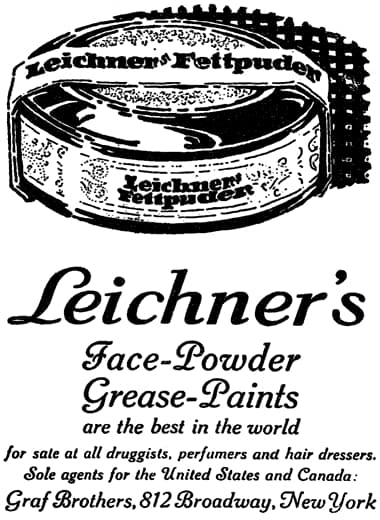
1913 Leichner Fettpuder distributed by Graf Brothers (United States).
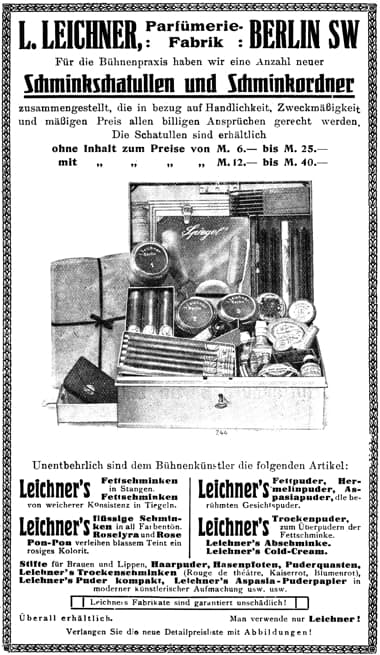
1916 Leichner Scminkschatullen und Schminkordner (Make-up boxes and folders).
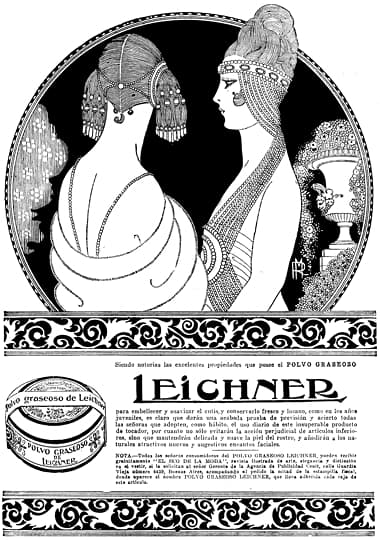
1921 Polvo Graseoso Leichner (Fettpuder) (Argentina).

1921 Leichner Kosmetiks.

1922 Leichner distributed by Vanities Ltd., London.
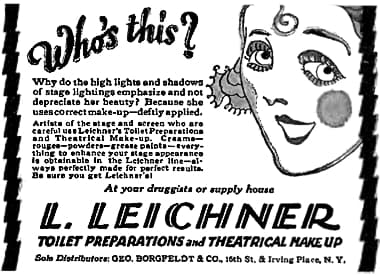
1923 Leichner distributed by George Borgfeldt & Co. New York.
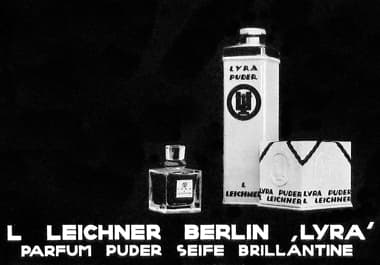
1923 Leichner Lyra Perfume, Powder, Soap and Brilliantine.
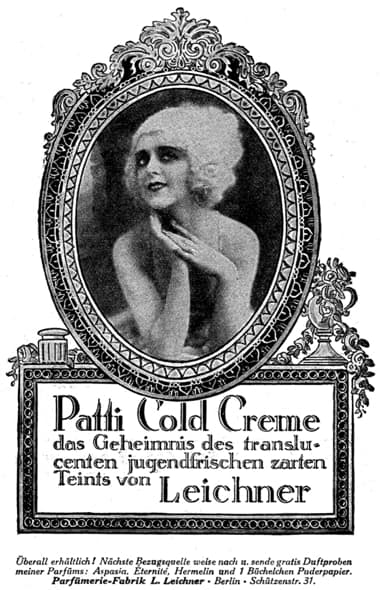
1924 Leichner Patti Cold Creme.

1925 Leichner Powder Compacts.

1925 Bluütenwasser von Leichner (Blossomwater), a type of Eau de Cologne.
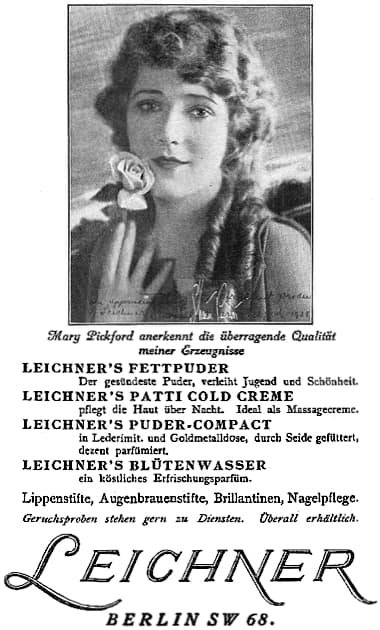
1927 Leichner endorsed by Mary Pickford [1892-1979].
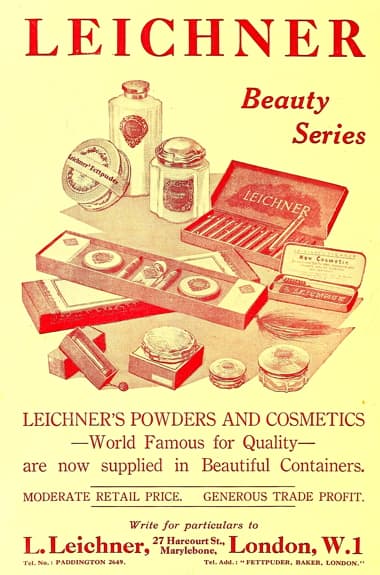
Above: 1927 Trade advertisement for Leichner Beauty Series (Britain). New lacquer-red packaging would be introduced by 1930.
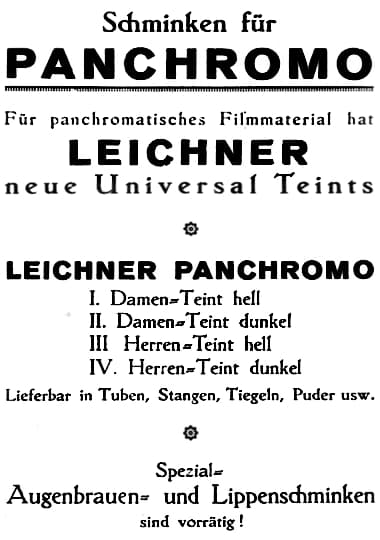
1928 Leichner Panchromo.

1928 Leichner No. 1001.
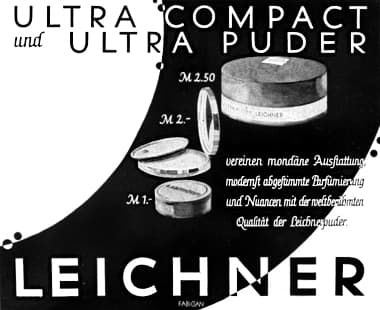
1928 Leichner Ultra Puder and Ultra Compact.
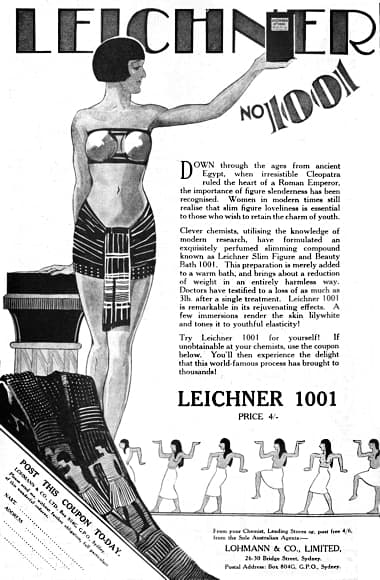
1929 Leichner 1001 (Australia).
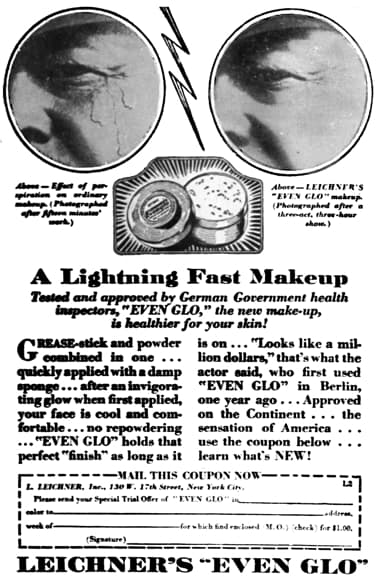
1929 Leichner Evengo (United States).
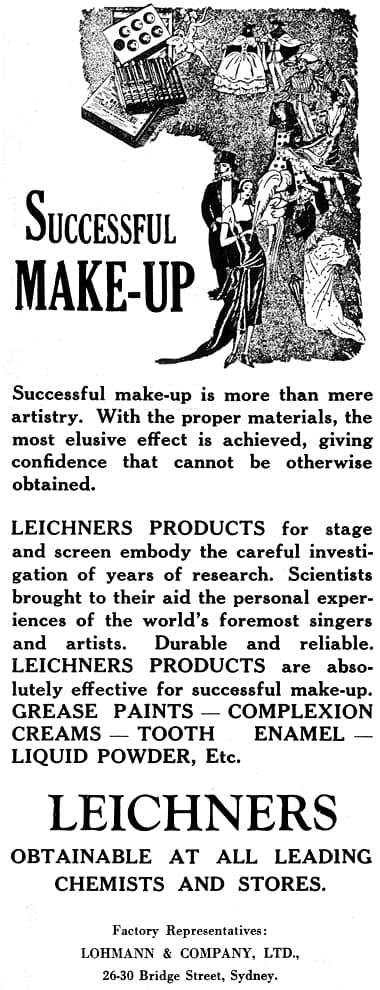
1929 Leichner (Australia).
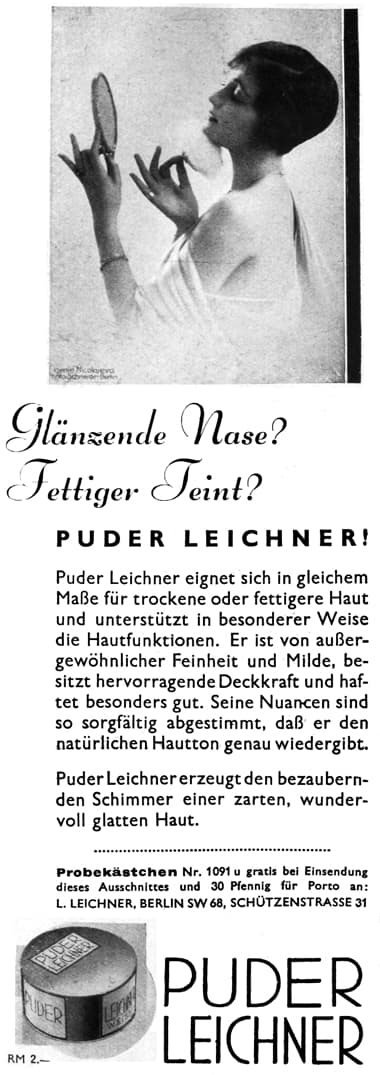
1930 Puder Leichner.
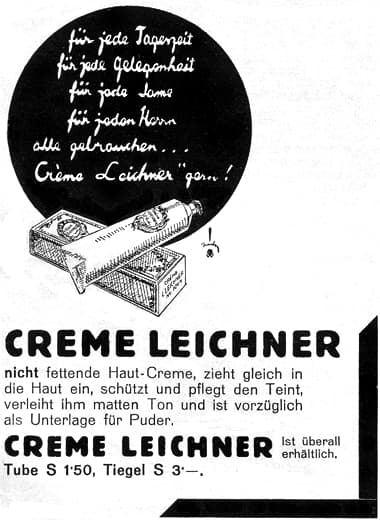
1930 Creme Leichner.
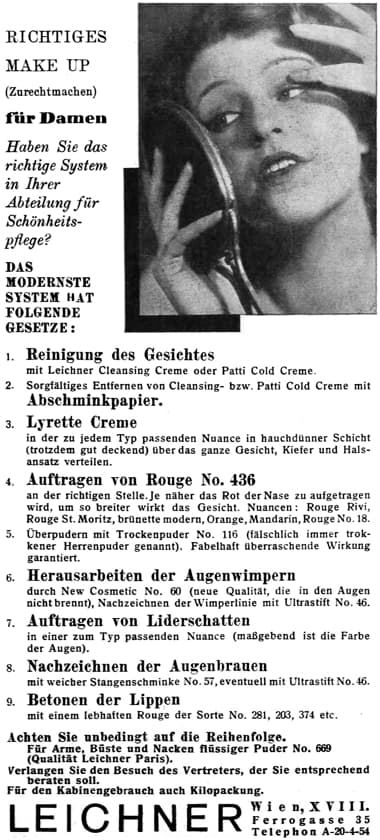
1931 Leichner Make-up.
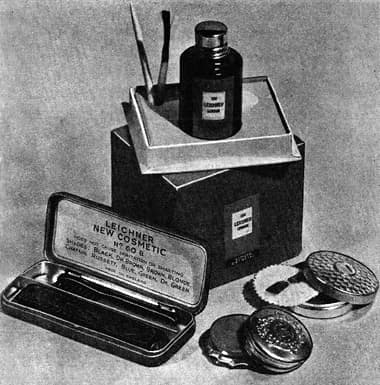
1933 Leichner eye cosmetics (Britain).
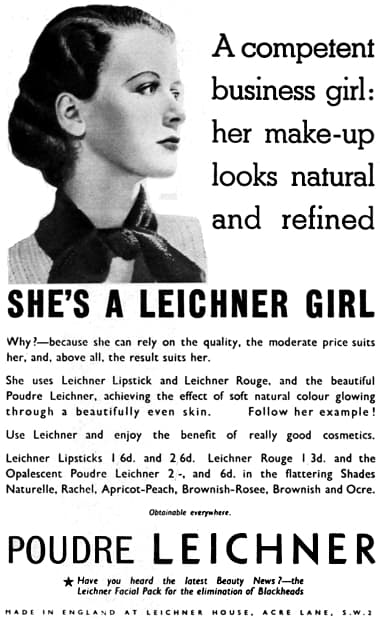
1936 Poudre Leichner (Britain).

1936 Leichner Removing Cream (Britain).

1937 Leichner Hormone Cream (Britain).
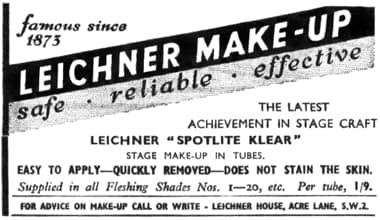
1937 Leichner Spotlite Klear (Britain).
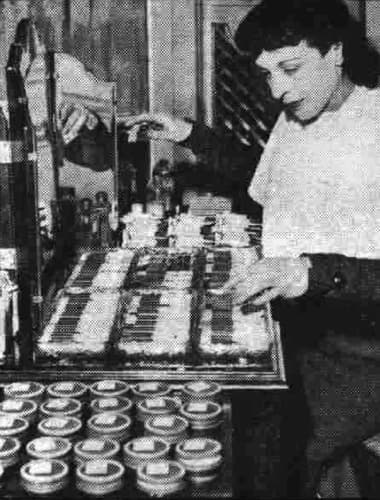
1937 Actress sampling make-up in Regent Street, London.

Above: 1938 Leichner Allcromo.
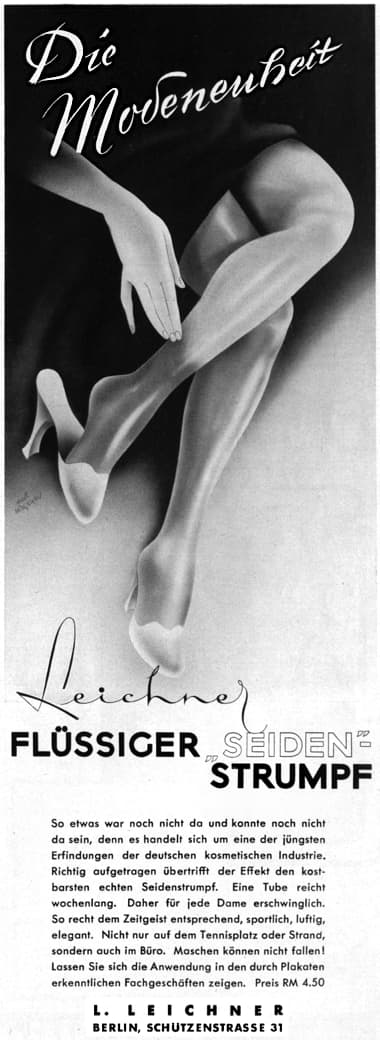
1938 Leichner Flüssiger “seiden”-strumpf, a cosmetic stocking.

1939 Leichner Liquid Cream Foundation (Britain).
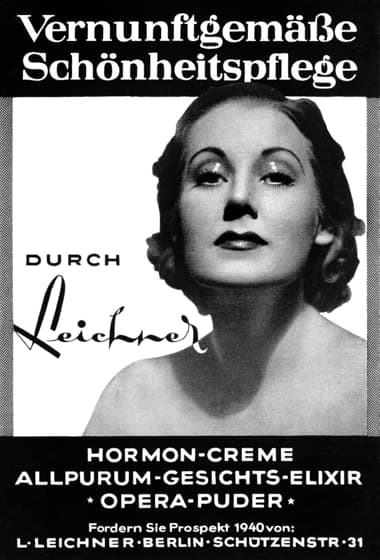
1940 Leichner Hormon-Creme, Allpurum-Gesichts-Elixir, and Opera-Puder.
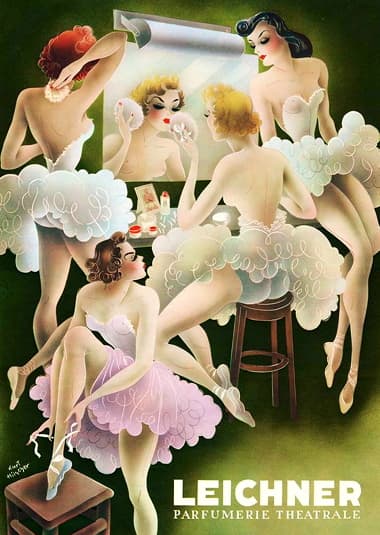
1941 Leichner Parfumerie Theatrale by the German commercial artist Kurt Hilscher [1904-1980]
